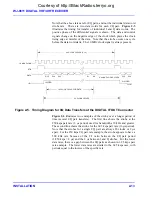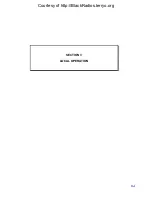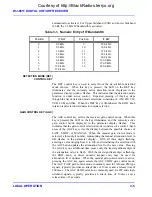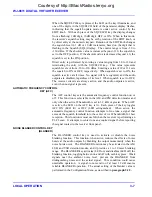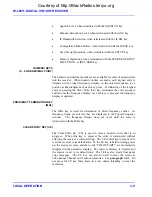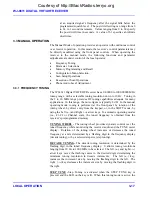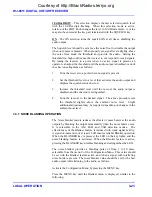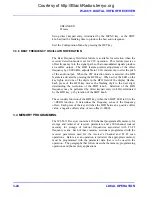
WJ-8611 DIGITAL VHF/UHF RECEIVER
LOCAL OPERATION
3-9
•
Squelch Level, when terminated with the SQUELCH key
•
Manual Attenuation Level, when terminated with the AGC key
•
IF Bandwidth Selection, when terminated with the IF BW key
•
Configuration Menu Entries, when terminated with the MENU key
•
Scan Set up Operations, when terminated with the SETUP key
•
Memory Operations, when terminated with the STORE/LOCKOUT,
EXEC/CHAN, or INCL/SKIP key.
NUMERIC
KEYS
(0 - 9 AND DECIMAL POINT)
The numeric and decimal point keys are available for entry of numeric data
into the receiver. When numeric entries are made, each keypad entry is
displayed in the tuned frequency display, in the entered sequence, as a
positive acknowledgment of each key press. Termination of the keypad
entry or pressing the Clear Entry (CE) key terminates the entry sequence
and restores the frequency display. As each key is pressed, the frequency
display is updated.
FREQUENCY TERMINATION KEY
(MHz)
The MHz key is used for termination of direct frequency entries. As
frequency digits are entered, they are displayed in the Tuned Frequency
window. The frequency change does not occur until the entry is
terminated with the MHz key.
CLEAR ENTRY KEY (CE)
The Clear Entry key (CE) is used to clear a numeric entry that is in
progress. When this key is pressed, the entry is terminated without
affecting the receiver’s current setting. The CE control key is also used to
reset the receiver to its default state. IF the CE key is held in during power
up, the receiver is reset, and the words “COLD START!” are momentarily
displayed in the parameter display. The receiver memory is cleared, and
the receiver is set to its default state. The CE key also clears front panel
error messages. The CE key can also be used to clear the receiver's
200-channel Channel and Lockout memories. See
paragraph 3.4.3
. Do
not press the CE key three times in a row unless intending to clear the
memories.
Courtesy of http://BlackRadios.terryo.org
Summary of Contents for WJ-8611
Page 3: ...A B blank Courtesy of http BlackRadios terryo org...
Page 4: ...THIS PAGE INTENTIONALLY LEFT BLANK Courtesy of http BlackRadios terryo org...
Page 19: ...1 i SECTION 1 GENERAL DESCRIPTION Courtesy of http BlackRadios terryo org...
Page 20: ...1 ii THIS PAGE INTENTIONALLY LEFT BLANK Courtesy of http BlackRadios terryo org...
Page 29: ...2 i SECTION 2 INSTALLATION Courtesy of http BlackRadios terryo org...
Page 30: ...2 ii THIS PAGE INTENTIONALLY LEFT BLANK Courtesy of http BlackRadios terryo org...
Page 47: ...3 i SECTION 3 LOCAL OPERATION Courtesy of http BlackRadios terryo org...
Page 48: ...3 ii THIS PAGE INTENTIONALLY LEFT BLANK Courtesy of http BlackRadios terryo org...
Page 85: ...4 i SECTION 4 REMOTE CONTROL Courtesy of http BlackRadios terryo org...
Page 86: ...4 ii THIS PAGE INTENTIONALLY LEFT BLANK Courtesy of http BlackRadios terryo org...
Page 119: ...5 i SECTION 5 CIRCUIT DESCRIPTIONS Courtesy of http BlackRadios terryo org...
Page 120: ...5 ii THIS PAGE INTENTIONALLY LEFT BLANK Courtesy of http BlackRadios terryo org...
Page 143: ...6 i SECTION 6 MAINTENANCE Courtesy of http BlackRadios terryo org...
Page 144: ...6 ii THIS PAGE INTENTIONALLY LEFT BLANK Courtesy of http BlackRadios terryo org...
Page 167: ...7 i SECTION 7 REPLACEMENT PARTS LIST Courtesy of http BlackRadios terryo org...
Page 168: ...7 ii THIS PAGE INTENTIONALLY LEFT BLANK Courtesy of http BlackRadios terryo org...
Page 243: ...A i APPENDIX A 8611 SM SIGNAL MONITOR OPTION Courtesy of http BlackRadios terryo org...
Page 244: ...A ii THIS PAGE INTENTIONALLY LEFT BLANK Courtesy of http BlackRadios terryo org...
Page 267: ...FP i FOLDOUTS Courtesy of http BlackRadios terryo org...
Page 268: ...FP ii THIS PAGE INTENTIONALLY LEFT BLANK Courtesy of http BlackRadios terryo org...
Page 298: ...Courtesy of http BlackRadios terryo org...

